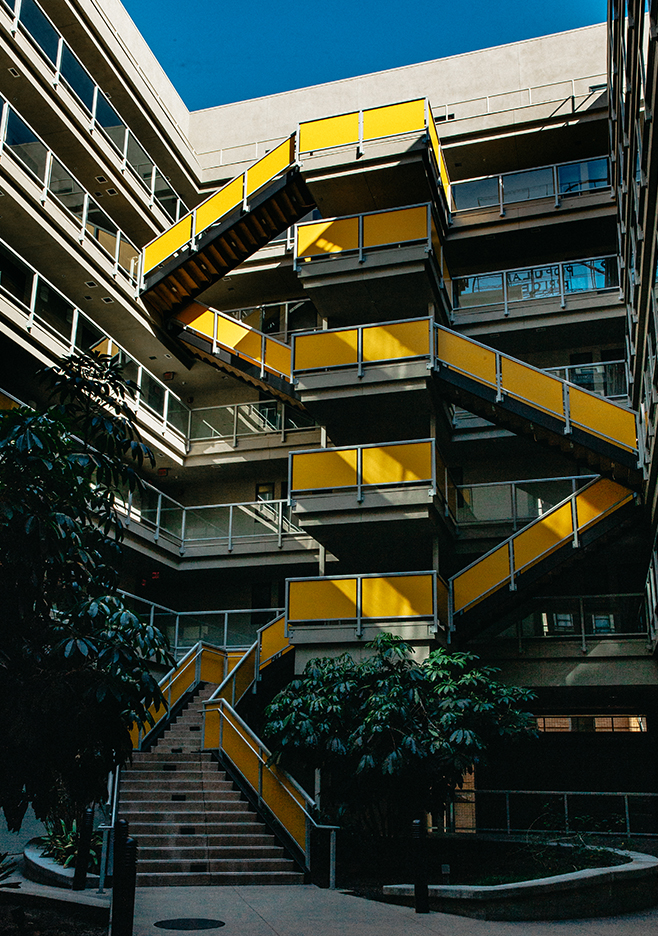Skid Row Housing Trust
Despite Downtown’s unprecedented boom, Skid Row has been the one constant that represents our economy’s, and culture’s greatest stumbling block. With opportunity and resources only available to the most powerful, those hit hardest by poverty, unemployment, addiction, and mental illness, free fall from the system. Downtown’s Skid Row has existed for a century due to an antiquated and centralized network of outreach for the homeless; nearly quarantined, so LA wouldn’t have to face a problem deemed too big and horrible to solve. But as countless new multimillion dollar luxury suites are in the works for LA’s young six-figure generation, Skid Row swells as the economy continues to marginalize the havenots. If this polarization continues, the culture and creative community that makes Downtown a destination is at risk of being priced out. It’s not as easy as decrying ‘gentrification’, it will be nothing short of ‘displacement’. Downtown will exist betwixt the glass towers and industrial barrel fires of the growing underclass of Skid Row.
For the last 25 years, the Skid Row Housing Trust (SRHT) has been committed to converting SRO’s (single resident occupancy) and otherwise dilapidated hotels into high quality apartments for Downtown’s homeless. Their ‘Housing First’ philosophy sees providing housing as the first step in ending the homelessness cycle. SRHT Corporate Relations and Events Manager Brad Robinson explains, “We believe that the most important need of the homeless is to be housed above all else. Before we can begin to tackle the many different and complex illnesses that this population is dealing with, it is most important that they are off the streets. Housing is like health care, that’s how we look at it. Let’s see how sleeping on a bed in a room you can lock effects not only your mental, but physical health. Let’s see how having the dignity of knowing where you can go to the bathroom every day or the security of a doorbell empowers you to rejoin the community.” For years they’ve worked with many amazing architects, like Michael Maltzan, to provide world class design of the new buildings, as providing ‘design equity’ is another tenet of the Trust. The Star apartments on 6th St. even boasts having Downtown’s largest rooftop organic garden, completely maintained by its residents. Brad explains, “We have former and current residents who have a say in the design of new properties. The people we’re trying to house have a direct influence on the design concept of the buildings”
Unlike most traditional low income housing, SRHT also provides both mental and health services onsite, in a non-punitive environment. Brad explains, “In the pace of today’s society and how organized one needs to be to get the services they need, especially if you are homeless, can be overwhelming. That’s why bringing in the services to the buildings themselves, is a huge benefit to not only the resident, but the taxpayer as well.” The Star apartments, is a spectacularly designed LEED Platinum certified building that includes a massive health and wellness center onsite. They’ve also worked with Killefer Flammang Architects to create the New Genesis Apartments on Main St., a mixed income community that designed for artists to occupy the market rate units as well. SRHT currently has 24 buildings Downtown with three more currently in development, like The Crest Apartments and The Six, which specifically service veterans who are chronically homeless.
Providing homes and healthcare for Skid Row is priority, but the Trust also considers how the Downtown community is impacted and involved. By decentralizing Skid Row, it removes large numbers of people from the violent, inhumane conditions of the area. By providing homes across Downtown, it keeps Downtown property values from skyrocketing, which would displace low to middle income residents further.
The plan to continue with future locations, means getting the community involved. They currently have partnerships in place with locals like Rotelli Cyclery, Petty Cash, and Boomtown Brewery to provide workshops, employment, and fund raising. Getting off the streets and into a home is just the beginning, so local businesses do their part to provide job training, product donation, or whatever they can to support. Brad says, “We have all these creative people in one pocket here, who better to start this humanitarian effort to change the way we perceive Skid Row?”
On this day they’re working with The Pie Hole, who’s donating 100 of their secret family recipe pumpkin pies for Thanksgiving at The Abbey on San Pedro St. The Pie Hole created a tiered donation program for its customers, allowing Piehole to bring their pies directly to the SRHT properties. Sales Director Lindsay Heffner says, “A lot of people want to help, but they don’t know how…this is a tangible solution they can be a part of.” For Heffner, SRHT is not just a partner for Piehole, but a means to engage their community and shape the culture, “This is how we can help. This (the SRHT) is a part of a solution, not just a Band Aid,” she says.
Anne Dobson, SRHT Director of Philanthropy & Communications says of the relationship with Piehole, “This challenges how we raise money, this type of concept is not being done at a typical non-profit, but it’s having great results.” For the SRHT, their biggest need now is awareness. Brad contends, “We have this time now where we can impart real change. A little bit of action goes a very long way here.”
Written by:
Scott Meisse
Photographed by:
Christian Thomas










